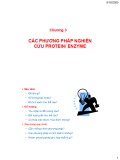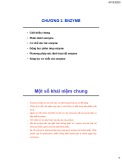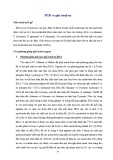
See discussions, stats, and author profiles for this publication at: https://www.researchgate.net/publication/327237513
PECTINOLYTIC ENZYMES: CLASSIFICATION, PRODUCTION, PURIFICATION
AND APPLICATIO
Article · August 2018
DOI: 10.26479/2018.0403.30
CITATIONS
35
READS
6,021
3 authors:
Anil R Shet
K.L.E. Technological University, Hubballi
37 PUBLICATIONS224 CITATIONS
SEE PROFILE
Shivalingsarj Desai
KLE Technological University, Hubballi
28 PUBLICATIONS166 CITATIONS
SEE PROFILE
Sharanappa Achappa
college of engineering and technology, jalgaon,india
36 PUBLICATIONS190 CITATIONS
SEE PROFILE
All content following this page was uploaded by Anil R Shet on 11 August 2020.
The user has requested enhancement of the downloaded file.

Shet et al RJLBPCS 2018 www.rjlbpcs.com Life Science Informatics Publications
© 2018 Life Science Informatics Publication All rights reserved
Peer review under responsibility of Life Science Informatics Publications
2018 May – June RJLBPCS 4(3) Page No.337
Original Review Article DOI: 10.26479/2018.0403.30
PECTINOLYTIC ENZYMES: CLASSIFICATION, PRODUCTION,
PURIFICATION AND APPLICATIONS
Anil Ramdas Shet*, Shivalingasarga Vijaykumar Desai, Sharanappa Achappa
Department of Biotechnology, K.L.E. Technological University,
Hubballi, Karnataka, India.
ABSTRACT: Microbial Pectinase has drawn great attention from various researchers worldwide
as a biological catalyst in a variety of industrial processes. Pectinase is an enzyme that breaks down
pectin, a polysaccharide found in plant cell walls. Pectinolytic enzymes are classified as
Protopectinases, Esterases and Depolymerases according to their mode of attack on the
galacturonan part of the pectin molecules. Pectinolytic enzymes are among the most important
industrial enzymes with wide-ranging applications in fruit juice industry, degumming of plant bast
fibers, wastewater treatment, wine industry, textile processing, paper making and coffee and tea
fermentations. The present review discusses the structure, properties and applications of pectin,
classification of Pectinase, production of microbial Pectinase, purification and biotechnological
applications of microbial Pectinase.
KEYWORDS: Pectin, Microbial Pectinase, Pectinolytic enzymes.
*Corresponding Author: Anil Ramdas Shet
Department of Biotechnology, K.L.E. Technological University, Hubballi, Karnataka, India.
Email Address: anil_shet@kletech.ac.in
1. INTRODUCTION
Enzymes are protein molecules in cells which work as catalysts. Enzymes speed up chemical
reactions in the body, but do not get used up in the process. Pectinases are a heterogeneous group
of related enzymes that hydrolyze the pectin substances. Pectin substances form the major
components of middle lamella, a thin layer of adhesive extracellular material found between the

Shet et al RJLBPCS 2018 www.rjlbpcs.com Life Science Informatics Publications
© 2018 Life Science Informatics Publication All rights reserved
Peer review under responsibility of Life Science Informatics Publications
2018 May – June RJLBPCS 4(3) Page No.338
primary cell walls of adjacent young plant cells. Pectinase are widely distributed in higher plants
and microbes [1]. They are importance for plants as they help in cell wall extension [2] and
softening of some plant tissues during maturation and storage [3, 4]. Pectinases accounts for about
10% of total enzyme production in the world market [5]. Pectinases are classified according to
their mode of secretion as extracellular and intracellular pectinases. An extracellular enzyme is
secreted outside the cell into the medium in which that cell is living. Extracellular enzymes usually
convert large substrate molecules into smaller molecules that can then be more easily transported
into the cell, whereas an intracellular enzyme operates within the cell membrane. Pectinolytic
enzymes are divided into three groups according to the cleavage site as hydrolases consisting of
polygalacturonase, lyase/trans-eliminases comprising pectinlyase and pectate lyase, pectin
esterase [6]. Pectinases are produced from different microorganisms such as bacteria [7, 8], yeast
[9], fungi [10] and actinomycetes [11, 12]. Amongst these, the filamentous fungi are most
commonly employed. Aspergillus niger is the most commonly used fungal species for industrial
production of Pectinolytic enzymes [13, 14, 15]. Intracellular as well as extracellular enzymes are
produced by fungi. All fungi are heterotrophic, which depend on carbon compounds produced by
other living organisms. Small molecules like mono disaccharides fatty acids and amino acids can
easily pass through but for breaking down of larger complex compounds like pectin, fungi secrete
extra cellular enzymes. The extra cellular enzymes are easier to be extracted when compared with
intracellular enzymes. The extraction of Intracellular enzymes requires more time and costly
chemicals. Pectinolytic enzymes can be produced by both submerged and solid state fermentation.
The materials of plant origin like grains such as rice, corn, root, tubers and legumes are used as
substrates for solid state fermentation. The pectinases have extensive applications in the extraction
and clarification of fruit juices and wine [16, 9, 17, 18].
Pectin- its structure, properties and applications
Pectin is a high molecular weight (194.139g/mol) heterogeneous and acidic structural
polysaccharide [19] which is one of the major constituents of cereals, vegetables, fruits and fibers.
It is the component of middle lamella and primary cell wall in plant cell wall and within the wall
forms a matrix in which a network of cellulose and hemicelluloses are embedded [20]. Pectin has
been characterized as having a backbone of D-galacturonic acid residues [21], linked by α(1–4)
linkage with a small number of rhamnose residues in the main chain and a rabinose, galactose and
xylose on its side chains. Pectin contributes to the mechanical strength and physical properties of
primary cell walls there by maintaining structural integrity. Pectic substances represent between
0.5-4% of fresh weight plant material [2, 22]. In addition to their role as cementing and lubricating
agents in the cell walls of higher plants, they are responsible for the texture of fruits and vegetables

Shet et al RJLBPCS 2018 www.rjlbpcs.com Life Science Informatics Publications
© 2018 Life Science Informatics Publication All rights reserved
Peer review under responsibility of Life Science Informatics Publications
2018 May – June RJLBPCS 4(3) Page No.339
during growth, maturation and their storage [16, 20]. Furthermore, pectic substances are involved
in the interaction between plant hosts and their pathogens [23]. The generic name of pectic
substances is used for referring to four types of molecules: protopectin: pectic substance in intact
tissue, pectinic acids: polygalacturonan containing >0-75% methylated galacturonate units, pectic
acids: polygalacturonan that contains negligible amount of methoxyl groups, and pectins: pectinic
acid with at least 75% methylated galacturonate units. Protopectines are insoluble in water, while
the rest are wholly or partially soluble in water [16, 24]. Pectins are used in the food and
pharmaceutical industries. In the food industry, it is primarily used as a gelling agent, replacing
sugars and/or fats in low-calorie food and as nutritional fiber [22, 25]. In pharmaceutical industry,
it is used to reduce cholesterol or to act as a lubricant in the intestines thus promoting normal
peristaltic movement without causing irritation. In addition, pectin’s are used as drug delivery
systems, which can also reduce the toxicity of these and make their activity longer lasting without
altering their therapeutic effects [26, 27, 28, 25].
Pectinase enzyme and its Classification
Pectinolytic enzymes comprise a group of enzymes that catalyze the breakdown of substrates
containing pectin. These are the one which hydrolyze pectic substances [9]. Pectic enzymes are
widely distributed in nature and are produced by bacteria, yeast, fungi and plants [21, 1]. In plants,
pectic enzymes are very important since they play a role in elongation and cellular growth as well
as in fruit ripening [3, 1]. Pectolytic activity of microorganisms plays a significant role, firstly, in
the pathogenesis of plants since these enzymes are the first to attack the tissue [23, 1]. In addition,
they are also involved in the process of symbiosis and the decay of vegetable residues [30, 29].
Pectinases are classified into three classes: pectin esterases, depolymerizing enzymes (hydrolases,
lyases), and protopectinases according to the following criteria: (1) whether, pectin, pectic acid or
oligo-D-galacturonate is the preferred substrate; (2) whether they act by trans-elimination or
hydrolysis; or (3) whether the cleavage is random (endo-, liquefying or depolymerizing enzymes)
or ‘endwise’ (exo- or saccharifying enzymes) [16]. Detailed classification and properties of
pectolytic enzymes are discussed in other literature on pectinases [16, 31, 22]. Protopectinases
solubilizes protopectin forming soluble pectin. Esterase (pectin methyl esterases and pectin acetyl
esterases) eliminates methoxyl and acetyl residues from pectin giving rise to polygalacturonic acid.
Depolymerases breaks down the glycosidic α-(1- 4) bonds between galacturonic residues via: 1.
Hydrolysis (polygalacturonases) 2. Transelimination (pectin lyases and pectate lyases) Also, the
latter enzymes are subdivided into endo- if its pattern of action is random or exo-if its pattern of
action is at the terminal end [32, 33, 3, 1].

Shet et al RJLBPCS 2018 www.rjlbpcs.com Life Science Informatics Publications
© 2018 Life Science Informatics Publication All rights reserved
Peer review under responsibility of Life Science Informatics Publications
2018 May – June RJLBPCS 4(3) Page No.340
Production of Microbial Pectinases
Pectinolytic enzymes are produced by many organisms like bacteria, fungi, yeasts, insects,
nematodes, protozoan and plants. The microbial world has shown to be very heterogeneous in its
ability to synthesize different types of Pectolytic enzymes with different mechanisms of action and
biochemical properties [21]. Microbial production of pectinases has been studied during recent
years [31]. Pectic enzymes are produced by both prokaryotic microorganisms, which primarily
synthesize alkaline pectinases, and by eukaryotic microorganisms, mostly fungi that synthesize
acid pectinases [30, 2, 31].Production of Pectinase has been reported from bacteria [11], yeast [34]
and fungi. All the commercial preparations of pectinases are produced from fungal sources [35].
Aspergillus niger is the fungal species for industrial production of Pectinolytic enzymes [21, 2].
Most extracellular induced enzymes are produced in higher quantities when inducers are present
in the cultivation medium [16]. Microbial enzymes are produced either through submerged
fermentation (SmF) or solid state fermentation (SSF) techniques. Submerged fermentation is a
well-developed system used in industrial scale to produce a large variety of microbial metabolites.
The SmF techniques for enzyme production are generally conducted in stirred tank reactors under
aerobic conditions using batch or fed batch systems. Submerged fermentation requires high
volumes of water, continuous agitation and generates lot of effluents. On the other hand solid state
fermentation involves microbial growth and product formation on or within particles of a solid
substrate under aerobic conditions, in the absence or near absence of free water and does not
generally require aseptic conditions for production of enzymes [36] Some of the advantages of
SSF processes over liquid-batch fermentation are that a lower volume of liquid is required for
product recovery, cheap media can be used for fermentation, and there is a lower risk of
contamination due to the inability of most contaminants to grow in the absence of free-flowing
substrate. Higher fungi and their enzymes, as well as spores or metabolites, are well adjusted to
growth on solid wet substrates. For instance, fungal spores produced by SSF show higher stability,
are more resistant to drying and exhibit higher germination rates for extended periods of time after
freeze-drying than do spores produced by SmF [37]. Solid state fermentation has only found
restricted applications in processes using unicellular organisms. The main obstacles are the low
amenability of the process to regulation, the strongly heterogeneous fermentation conditions and
the ensuing frequently unsatisfactory reproducibility of the results, difficult scale-up, the often
unfeasible biomass determination and complicated product purification by downstream processes
resulting from the use of heterogeneous organic growth substrates [38]. Agricultural and food
processing wastes such as wheat bran, cassava, sugar beet pulp, citrus waste, corn cob, banana
waste, saw dust and apple pomace are the most commonly used substrates for SSF for Pectinase






![Bài giảng Enzyme Công nghiệp [mới nhất]](https://cdn.tailieu.vn/images/document/thumbnail/2019/20190927/kuronato/135x160/2591569591154.jpg)

![Giáo trình Công nghệ Enzim Phần 2: [Mô tả/Định tính nếu cần]](https://cdn.tailieu.vn/images/document/thumbnail/2016/20160604/tangtuy14/135x160/1762485882.jpg)
![Giáo trình Công nghệ Enzim Phần 1: [Thêm Mô Tả Chi Tiết Hấp Dẫn Hơn Về Nội Dung]](https://cdn.tailieu.vn/images/document/thumbnail/2016/20160604/tangtuy14/135x160/2028746805.jpg)











![Đề cương ôn thi Phụ gia thực phẩm [năm hiện tại]](https://cdn.tailieu.vn/images/document/thumbnail/2025/20251120/kimphuong1001/135x160/63671763608893.jpg)




